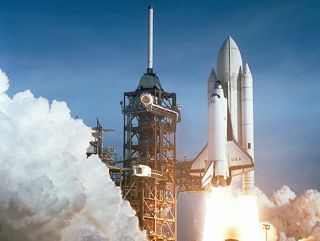
Space Shuttle Anniversary
- 14th Apr 2016
- Author: Tamela Maciel
Shuttle Begins
This week marks the anniversary since the first Space Shuttle launch, a programme that ferried 355 different astronauts along with millions of pounds of cargo, satellites, and even secret military missions into space for the next 30 years.
Space Shuttle missions built the International Space Station, fixed the Hubble Space Telescope five times, captured broken satellites mid-orbit and released them repaired, and perhaps most significantly, pioneered the concept of a reusable space vehicle. Five years since the end of the programme, private space companies are now building on the lessons learned from Shuttle.
On 12 April 1981, exactly twenty years after Yuri Gagarin became the first man in space, the Space Shuttle Columbia blasted off from Cape Canaveral in Florida. John Young, a veteran Apollo astronaut with a Moon landing under his belt, and rookie astronaut Bob Crippen orbited the Earth 36 times in Columbia before gliding to a perfect landing on a desert runway in California. This marked the beginning of a Shuttle era that would see 133 successful launches over 30 years.
Concepts
NASA explored designs for a low-cost, reusable space shuttle even before the first Moon landing with concept drawings that look remarkably similar to the final, iconic winged design.
The idea was driven by the need to keep costs low with a spacecraft that could land, be refurbished within a few weeks, and be ready to launch again.
Columbia, Challenger, Discovery, and the other Shuttle siblings made going into space routine, but they didn’t make it cheaper.
After landing, each Shuttle required far more inspection and repair than NASA engineers initially thought. The heat-resistant tiles that protected the outside of the Shuttle during re-entry were especially problematic. They needed constant replacement and delayed how quickly a Shuttle could be ready to launch again.
The Columbia disaster in 2003 forced NASA to reconsider the safety of the ageing Shuttle programme and after several final flights to finish building the International Space Station, the last Space Shuttle flew in 2011.
Private Company Launches
Today we’re seeing a rebirth of reusable spacecraft, driven by private companies keen to push the envelope of what’s possible and keep their costs low.
In November 2015, Blue Origin was the first company to successfully land a rocket upright after launching it into space. They reused the same rocket in a second launch in January and a third launch on 2 April 2016, and are now making plans to fly space tourists on sub-orbital flights.
Falcon 9
SpaceX followed hard on the heels of Blue Origin, completing an upright landing of their Falcon 9 rocket in December 2015, after first launching a satellite into space. In April 2016 they performed the same trick, but at sea, landing Falcon 9 on the rolling surface of a ship. Since spacecraft are almost always launched over sea for safety reasons, this latest feat means that SpaceX won’t have to carry extra fuel in order to fly the rocket back to land.
The Space Shuttle programme boasts a long list of impressive feats, but it never quite achieved the goal of reducing the cost of going to space.
However, the reusable ethos it pioneered has paved the way for a new generation of space flight companies intent on making the journey to space routine and sustainable.




